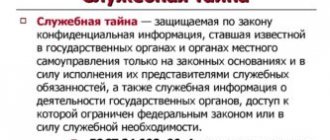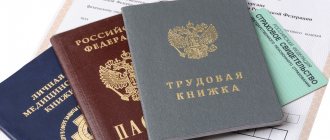Features of the agreement
A Confidential Information Agreement is a legal document concluded by two parties for the purpose of mutual exchange of information during cooperation. At the same time, third parties' access to confidential information is limited. Contractual relations are characterized by the manifestation of special trust of the parties in relation to each other. The non-disclosure obligation does not affect the right of the parties to disclose information obtained from public sources.
The parties to the agreement are:
- confidant – transfers classified information to the other party;
- confidential - receives such information and undertakes to provide limited access to it.
When drawing up an agreement, its participants set themselves the following goals:
- oblige the other party not to disclose confidential information received;
- in case of violation of this obligation, bring those responsible to justice and force them to compensate for losses.
The requirement to protect confidential information is regulated, among other things. Federal Law “On Trade Secrets” dated July 29, 2004 No. 98-FZ, Law on Information No. 149 dated July 27, 2006, Decree of the President of the Russian Federation No. 188 dated March 6, 1997.
How and why to use it
In Russian Legislation it is not the main form, more often as an annex to an employment contract. The design is not regulated, but there are samples containing the necessary information and wording.
By signing the paper, the employee agrees that if he receives information about the company, he will not give it to competitors. If a violation occurs, the employee is issued a fine, and according to the article, he may be fired.
Non-disclosure agreement
OJSC "_______________________________________", hereinafter referred to as the "Employer", represented by the General Director ___________________, acting on the basis of the Charter, on the one hand, and ________________________________, passport _____________, issued by _______________________, registered at the address: _______________________, hereinafter referred to as the "Employee", with the other parties have entered into this agreement on non-disclosure of confidential information, hereinafter referred to as the “Agreement”, as follows:
1. Subject of the agreement 1.1. The Employee undertakes the obligation not to disclose information constituting confidential information of the Employer that has become known to him in connection with his work in the Company. 1.2.
Confidential information in the Agreement means any information that has actual or potential commercial value due to its unknownness to third parties, to which there is no free access on a legal basis and to maintain the confidentiality of which the owner takes all possible measures. 1.3.
The list of information related to confidential information is defined in the Regulations on Confidential Information in the Company. 1.4.
Information constituting confidential information can be transmitted to the employee orally, in writing, in the form of photographs, electronically, graphically, or in any other form. 1.5.
Expert opinion
Kostenko Tamara Pavlovna
Lawyer with 10 years of experience. Author of numerous articles, teacher of Law
Under this Agreement, the information specified in clauses 1.3 and 1.4 of the Agreement cannot constitute confidential information: 1.5.1. which were publicly disclosed prior to the conclusion of this agreement; 1.5.2.
which became publicly available during the term of this agreement, but without the culpable participation of the relevant party. 1.6.
The Employee, by signing this agreement, certifies that he is familiar with the Regulations on the Protection of Trade Secrets of the Employer.
2. Rights and obligations of the parties 2.1.
The Employee undertakes not to disclose information constituting confidential information of the Employer that has become known to him in connection with his work in the company, as well as to protect the above information from encroachments and attempts to make it public by third parties. 2.2.
The Employee undertakes to use the information obtained in the performance of his work duties only in the interests of the Employer. 2.3.
The employee undertakes, after finishing work for the company, not to use information obtained in connection with work for the company for the purpose of competition with another company. 2.4.
All information constituting confidential information and received by the Employee in tangible (diagrams, drawings, letters, photographs, etc.) and intangible forms is the exclusive property of the Employer and is used only under the terms of the Agreement. 2.5.
Upon termination of the employment contract, the Employee undertakes to return all information received from the other party on tangible media, as well as copies thereof, within one day from the date of the first request. 2.6.
In the event of disclosure of information constituting confidential information under this agreement, the Employee is obliged to fully compensate the losses incurred by the Employer as a result of such disclosure, the amount of which is determined by an independent expert commission. 2.7.
This is important to know: Can a pregnant woman be fired from her job?
The employee confirms that he has been warned that, in accordance with the legislation of the Russian Federation, disclosure of information constituting confidential information may entail civil, administrative and criminal liability.
3. Duration of the agreement 3.1. This agreement comes into force from the moment it is signed and is valid for 3 years from the date of termination of the employment contract.
4. Force majeure (force majeure) 4.1.
The parties are released from liability for partial or complete failure to fulfill obligations under this agreement if the failure was a consequence of natural phenomena, external objective factors and other force majeure circumstances for which the parties are not responsible and the adverse effects of which they are unable to prevent.
5. Final provisions 5.1.
The Agreement is concluded in 2 copies having equal legal force, one copy for each Party. 5.2.
Any agreement between the Parties entailing new obligations that do not arise from the Agreement must be confirmed by the Parties in the form of additional agreements to it. All changes and additions to the Agreement are considered valid if they are in writing and signed by appropriate authorized representatives of the Parties.
5.3. A Party does not have the right to transfer its rights and obligations under the Agreement to third parties without the prior written consent of the other Party.
5.4. References in the Agreement to a word or term in the singular include references to that word or term in the plural.
Expert opinion
Kostenko Tamara Pavlovna
Lawyer with 10 years of experience. Author of numerous articles, teacher of Law
References to a word or term in the plural include references to that word or term in the singular. This rule is applicable unless otherwise follows from the text of the Agreement.
5.5. The Parties agree that, with the exception of information that, in accordance with the legislation of the Russian Federation, cannot constitute confidential information of a legal entity, the contents of the Agreement, as well as all documents transferred by the Parties to each other in connection with its conclusion, are considered confidential and relate to the secrets of the Parties, which shall not be disclosed without the written consent of the other Party.
5.6. For purposes of convenience, in the Agreement, the Parties also mean their authorized representatives, as well as their possible successors.
5.7. Notifications and documents transferred under the Agreement are sent in writing to the following addresses: 5.7.1.
For the Employer: _____________________________________________________. 5.7.2.
For the Employee: ______________________________________________. 5.8. Any messages are valid from the date of delivery to the appropriate correspondence address. 5.9.
In case of changes in the addresses specified in clause 5.7.
Agreement and other details of the legal entity of one of the Parties, it is obliged to notify the other Party about this within 10 (ten) calendar days, otherwise the Party’s fulfillment of obligations under the previous details will be considered proper fulfillment of obligations under the Agreement. 5.10.
The Parties agreed that disputes and disagreements that may arise between the Parties and arising from this agreement or in connection with it will be resolved through negotiations. If it is impossible to reach an agreement on controversial issues through negotiations within 15 (fifteen) calendar days from the receipt of a written claim, the disputes are resolved in court.
Moscow at the place of registration of the Customer (contractual jurisdiction) in accordance with the current legislation of the Russian Federation.
A non-disclosure agreement for confidential information - a sample of this agreement is popular on the Internet primarily due to the desire of managers of commercial and other enterprises to protect valuable information from competitors. For what purpose is this document being drawn up and what are the consequences of its conclusion, read our article.
Types of agreements
- Unilateral agreement. The exchange of confidential information occurs unilaterally. An example of such a contractual relationship is the transfer of information by the employer to hired employees to perform their labor functions.
- Mutual agreement. The parties share information with each other that should be kept private for third parties. Most often, such an agreement is concluded between business partners, counterparties, during a merger of companies.
A non-disclosure agreement for confidential information can be used by organizations and individual entrepreneurs both before entering into transactions and throughout the entire period of cooperation. This document can also be used by employers when employing employees in order to prevent them from disclosing classified information entrusted to them for work.
In order for a document to be legally binding, both parties must sign it. If one of the parties or both parties are legal entities, the agreement should be sealed.
Important points that need to be reflected in the agreement
- Determination of the object of contractual relations (confidential information).
- A detailed list of information that is confidential and which is not.
- Rights and responsibilities of participants regarding restricting access to confidential information.
- The period during which participants are obliged to comply with the terms of the agreement.
- A list of situations that will be considered a violation of the agreement.
- List of trusted persons to whom confidential information may be disclosed partially or in full.
- Responsibility measures for disclosure of information.
How to write an NDA
The non-disclosure agreement does not have a rigid form. Here's what to consider:
- Determine the owner of the sensitive data. The contract is concluded on his behalf.
- Specify the parties who sign the NDA and define how sensitive data is shared with third parties. For example, an agreement is concluded with a company represented by its general director. But the information will get to the employees who will work with it. Therefore, one of the obligations may be to “bring to the attention of all persons with access to confidential data the provisions of this agreement.”
- Describe what is meant by disclosure of information. This may be used for personal gain, transferred to third parties, and so on.
- Indicate which non-trade secret data is considered confidential under the agreement.
- Indicate that the recipient of the information must make every effort to protect it.
- Determine methods for transmitting confidential information: on tangible media, through a messenger, by carrier pigeons.
- Set the NDA expiration date. Even if you stop cooperating, the data will remain confidential during this period.
- Determine the sanctions for violating the non-disclosure agreement. It is better to prescribe a fixed fine than an obligation to compensate for damage. It will be difficult to prove the latter; good reasons are needed for this. For example, a client left you after distributing information. But “after” does not mean “as a result.” To prove damage, you need to get an admission from the client that he did this because of the leaked data. And to pay a fixed fine, the very fact of disseminating information is sufficient.
As a result, the non-disclosure agreement may look like this or this.
How to draw up a confidential information agreement?
The current legislation does not contain rules regulating the form of this document and the procedure for its conclusion. Each organization develops its own version. Most often, the agreement is drawn up in the form of an agreement, a contract or an annex to an employment contract, a civil contract agreement. The indicative structure of the document is given below:
- Introductory part. Here the name of the document, the date and place of its preparation are indicated, and the parties to the agreement are listed.
- Section "Subject of the agreement". Information that is subject to confidentiality is listed here.
- Section “Obligations and Responsibilities of the Parties”. This paragraph prescribes liability measures for the disclosure of confidential information and requirements for its protection. You can also indicate here exactly what circumstances will not constitute a violation of the concluded agreement (for example, disclosure of information at the written request of government authorities).
- Section "Other conditions". This paragraph can include the procedure for the parties to act in the event of an emergency.
- Section “Addresses, details and signatures of the parties.”
Agreement on non-disclosure of confidential information: samples, with an employee, between legal entities. persons
Last modified: January 2020
The state at the legislative level has defined the concept of a trade secret and provides for the protection of confidentiality and protection from unauthorized access.
A document agreement between the parties on the non-disclosure of confidential information is concluded, which is an annex to the employment or civil law contract.
The agreement specifies the subject matter that represents the secret protected by the business entity, the responsibilities of the “initiate” for preservation and responsibility for violating the “vow of silence.”
Legal regulation
The protection of certain information classified as a trade secret is provided for by Law No. 98-FZ of July 29, 2004. According to the definition, this information has value when unknown to third parties and contributes to obtaining economic benefits.
At each stage of negotiations with a partner or employee, an enterprise can draw up a document on non-disclosure of confidential information, reducing business risks. It is important to define in writing what exactly a trade secret includes, since only the information that is to be excluded is legally defined.
The information confidentiality agreement provides for the subject of the agreement, which contains a specific list that is not subject to disclosure regarding:
- management methods and business strategy of the enterprise;
- execution of a number of decisions on commercial, organizational, scientific, technical and production issues;
- capital investments, production volumes, concluded transactions;
- methods and results of market monitoring;
- technical and economic data.
At its own discretion, in order to maintain confidentiality, the initiating party may additionally enter items with the exception of information directly prohibited by Article 5 of Law No. 98-FZ:
- publicly available data contained in the Unified State Register of Legal Entities;
- information contained in special licenses and permits for a certain type of activity;
- data on arrears of wages and contributions to social funds;
- average number and composition of employees;
- about persons who have the right to represent the company without a power of attorney.
The non-disclosure document provides for liability for failure to fulfill obligations and the period during which the information constitutes a trade secret. The terms are not limited by law, therefore, in the case of the development and implementation of promising technology, it is advisable to set a minimum limit of five years.
The procedure for drawing up an agreement on non-disclosure of confidential information
An agreement on the non-distribution of information is concluded with employees who are required to own data classified as a protected secret due to the performance of their job function and between legal entities that are partners or intend to become them.
Agreement with an employee – an individual
Issues of maintaining trade secrets with hired personnel are recorded at the time of hiring or as the employee is involved in activities using “secret” data. The agreement on non-disclosure of confidential information with the employee is an integral annex to the employment contract with the mandatory reflection of the following sections:
- Subject of the agreement. Data related to protected secrets entrusted to the employee in view of the performance of assigned duties are specified in detail.
- Rights and obligations of the parties. Section contains:
- employee obligations regarding working with classified information, directions and restrictions on use;
- Management's responsibilities to create conditions for the security of confidential data, including restricting access by third parties.
- Special conditions. The section provides:
- types of liability, including disciplinary (dismissal for gross violation of labor discipline), material (compensation for damages);
- procedure for resolving controversial issues.
Trying to protect themselves, a number of employers include in a non-disclosure agreement with an employee information that is directly prohibited by law or that infringes on the rights of citizens.
A ban on engaging in entrepreneurial activity of a similar type or subsequent employment with competitors allows a citizen to prove in court not only the illegality of the demands, but also to cast doubt on the fact of the conclusion of the agreement.
Agreement with a partner – legal entity
When trying to enter into a partnership, a company must lift the “veil” of trade secrets in order to interest the counterparty. At the negotiation stage, a letter of confidentiality is allowed, a sample of which contains a prohibition on disclosing the specified information.
The rule provided for in Article 434.1 of the Civil Code of the Russian Federation applies regardless of whether a civil transaction takes place in principle. An official agreement on non-disclosure of confidential information can be drawn up after signing the main agreement on joint activities. The contractual structure is classified as unnamed on the basis of Article 421 of the Civil Code of the Russian Federation, since it is not directly stated.
The document requires preparation in writing. A confidentiality agreement between organizations is drawn up; the sample should include:
- An item with a detailed decoding of information related to a trade secret.
- Obligations to comply with non-disclosure of information assigned to:
- one side, if the second participant transfers valuable information unilaterally;
- both parties, if the transfer of important information is carried out mutually.
- Responsibility of the participating parties, including:
- punitive and financial sanctions;
- compensation for losses and lost economic benefits.
In addition to the Civil Code, which provides for the regulation of transactions of a civil nature, and the Labor Code, which regulates the interaction between the employer and hired personnel, in case of failure to maintain confidentiality of data, which led to significant losses, it is possible to bring criminal liability to both a legal entity and an individual.
Free question to a lawyer
Need some advice? directly on the site. All consultations are free / The quality and completeness of the lawyer’s response depends on how completely and clearly you describe your problem:
© 2020 zakon-dostupno.ru
Source: https://zakon-dostupno.ru/kadryi/soglashenie-o-nerazglashenii-konfidentsialnoy-informatsii/
What will be the consequences for violating the confidentiality regime?
The party that allows the disclosure of confidential information will have to bear responsibility:
- If the declassification of information occurred due to the negligence of employees, they will face disciplinary action, including dismissal.
- A deliberate leak of information for mercenary or other reasons may entail an obligation to compensate for all losses incurred.
- If an attacker intentionally collected information constituting a commercial or legally protected secret for the purpose of further disclosure, he will have to answer under Article 183 of the Criminal Code of the Russian Federation. This article provides, incl. imprisonment for up to 7 years if the disclosure entailed grave consequences.
- Article 13.14 of the Code of Administrative Offenses of the Russian Federation provides for penalties for violators in the following amount: for citizens - from 500 to 1000 rubles, for officials - from 4000 to 5000 rubles.
To protect important information from leakage, it is not enough to simply recognize it as secret. The management of the organization must take a set of legal measures. The main one should be the development and approval of the Regulations on Confidential Information. It may be necessary to create a separate unit whose employees will be responsible for protecting information.









